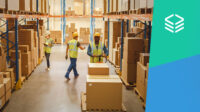A reliable supply chain is the heart of any retail business. However, it’s not a set-it-and-forget-it operation. To ensure your inventory is getting where it needs to go, on time, in the manner you intended, visibility into supply chain logistics is essential. Without the necessary supply chain and logistics visibility, business growth initiatives will fail, and profits will drop.
Before diving into the reasons why supply chain visibility is important, it’s necessary to define what is supply chain visibility and who it applies to. Supply chain visibility is the ability to know where your inventory is at every stage of the process through data. It’s being able to track inventory using the right fulfillment software at every point along the way until it reaches a customer’s door.
This visibility is important for all business stakeholders to have access to, which includes everyone from warehouse representatives to customer service support. Knowing how much inventory is in stock, how much of it is being shipped, and where it’s being shipped helps optimize inventory management and overall production. Here are additional reasons that answer the question of “Why is supply chain visibility important?”
Meets Customer Demand
Customers have choices when deciding when and where to shop. Shoppers today are shifting to ecommerce, and more and more purchasing on mobile devices –in fact 79 percent of smartphone users have made a purchase online using their mobile device this year – and consumers want seamless, fast delivery to follow the easy online shopping experience. This has increased competition among brands to produce the most quality items and deliver them in the fastest and most convenient methods.
Retailers must streamline their online and offline channels to ensure the shopper experience is consistent and favorable regardless of which channel they use to buy. Without supply chain visibility, there’s no way retailers effectively can track shipments, maintain order accuracy, or keep up with the demand of today’s buying trends. This can lead to supply chain disruption, poor customer response time and experiences, all of which lead to missed opportunities and dwindling sales.
Plan Inventory Needs
In addition to preventing potential problems, visibility into supply chain logistics is also essential in forecasting inventory needs. Knowing how much inventory is shipped during a set period helps retailers plan their high and low sales seasons. It also helps them prepare for an influx of sales and compete with others during busy shopping cycles, such as the holiday months. Plus, retailers can restock low inventory in advance to avoid out-of-stock messages for customers.
Retailers that use a solution like Flowspace to align their offline and online channels in one platform can review which areas are performing higher than others and make operational decisions according to the data. Understanding the ebb and flow of sales cycles and attributing sales and other business metrics to specific channels is a significant part of what helps companies grow and scale for success.
Maximizes Quality Control
Maintaining real-time supply chain visibility also helps maximize quality control. Common customer complaints include delayed shipments, broken packages, or shipments delivered to the wrong place. Having real time visibility over the entire supply chain can prevent these problems from occurring or catch them before they grow into a larger situation.
Without supply chain visibility, it’s difficult to identify the bottlenecks of where problems originate from, making it impossible to provide quality customer service. Customers want to receive their products in the way they‘re presented in a company’s physical store or online website. When they receive products that don’t live up to their expectations, it often leads to poor product reviews, minimizes the chance of repurchase, and diminishes customer loyalty.
Improves Overall Workflow
Essentially, supply chain visibility gives you access to all pertinent information at every point along the way. It allows retailers to mitigate any supply chain disruption and troubleshoot problems as they’re happening. This prevents them from spinning into a larger problem and taking away from the operational workflow.
Easy accessibility to operational data also increases agility and adaptability, allowing for the opportunity to pivot based on what the data reveals. This helps retailers create contingency plans and forecast projections to better support business sustainability.
Following a Supply Chain Visibility Process
What is meant by supply chain visibility in terms of creating a process? Tracking inventory from suppliers to the moment it reaches a customer’s doorstep is made up of several steps to ensure everything in the shipment is correct and the order is received in excellent quality and on time. Each shipment has a detailed order status that includes information such as:
- Supplier order receipt
- Delivery date from the supplier
- Shipping details
- Customer and regulatory information
- Order status
This information should be documented and trackable in real-time to review any potential delays before it arrives at the warehouse for storage. From there, the fulfillment logistics part of the supply chain involves storing, picking, packing, and shipping the goods.
Storage
Retail operations typically rely on warehouses to store their inventory while it’s waiting to be shipped to customers. At Flowspace, we make recommendations as to which warehouses are closest to your customer base to save on costs and adhere to the quick shipping schedules customers expect. With warehouses spread out across the U.S., we can accommodate businesses that need multiple storage areas and help strategize which one is the best region.
Picking
Once an order is placed, a fulfillment associate picks the products from the shelf and organizes them per shipment. This includes cross-checking the quantity and specifics of the order, as well as quality control of the inventory itself. This step also includes confirmation of customer information for proper packaging.
Packing
The packing process ensures products are packed securely and with a company’s unique branding intact. From customized packaging materials to special assembly, the packing part of the supply chain process is to ensure your customers receive their shipment in the way it was displayed on your website, social media, or at your physical storefront.
Shipping
Quick, on-time shipping is one of the biggest factors consumers consider when making a purchase. Being able to track shipments from the time they leaves the warehouse to the time a package arrives at a customer’s doorstep allows predictive visibility into the arrival date. It also shows any potential reasons for the delay to communicate with the customer as soon as possible versus after the package has already arrived late.
Having real-time visibility across the entire fulfillment process helps keep retailers informed to better meet customer demand and expectations. This is especially helpful when integrating sales information from various channels and warehouses into one online command center. Following a consistent process improves efficiency, helps to maintain costs, and boosts customer satisfaction, all of which help lead to larger profits and business growth.
How Digital Trends Are Shaping Supply Chain Visibility
Supply chain visibility is essential for merchants so they can stay informed, empowered, and leverage business decisions throughout the entire process, from freight to fulfillment to delivery. Technology is making this easier for retailers to access and implement into their operations thanks to digital trends, such as cloud-based systems and increased automation.
Cloud-Based Systems
Moving away from paper-based systems and digitizing manual processes creates better efficiency and accuracy for supply chains. Rather than filling out order paperwork for each individual shipment, the same information can be entered and saved across an online platform.
Saving data in a protected cloud-based system keeps sensitive information secure. Maintaining accurate, up-to-date data and information also allows business leaders to make informed decisions regarding all aspects of business, including inventory, suppliers, storage, and transport.
Automation
Automation is another way supply chain visibility has been improved through digital technology. It cuts down on repetitive data entry tasks to enhance efficiency within the supply chain operations. Rather than each warehouse manually inputting order information into their own system to sync at a later date, the information is updated in real-time and can be accessed from anywhere.
Flowspace serves as a retailer’s central command center and seamlessly integrates all marketplaces and shopping carts to automate the fulfillment process. All customer and inventory data is gathered in one single platform.
Omnichannel Retail
Omnichannel retail has changed the ways businesses connect with their customers. From social media to an online marketplace to an in-store experience and back again, the customer journey is varied. It’s essential for retailers to provide the same quality and positioning across the board and connect their various channels into one cohesive strategy.
Digital trends continue to drive consumer shopping habits. In turn, retailers must continue to provide solutions that provide what their customers want and need in real-time in order to stay competitive for what’s to come, considering the future of omnichannel retailing.
Improving Supply Chain Visibility
Maintaining supply chain visibility and creating a flexible supply chain strategy keeps you ahead of any potential problems or delays and allows you to adapt accordingly. And fortunately, the technology available today makes improving supply chain visibility easier than ever. By integrating all supply chain data into one central spot, it provides an overview of where and when shipments are coming in and going out.
It also provides supply chain transparency to uncover areas of improvement at each point. Whether that calls for better collaboration with suppliers or transporting inventory to a warehouse closer to a customer base, supply chain data helps drive actions that make a difference for the growth and success of a business.
At Flowspace, we power our solutions with advanced technology to help retailers thrive. For more information about how we can equip your business with better visibility into supply chain performance, contact us today.






